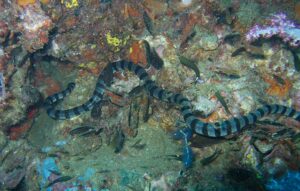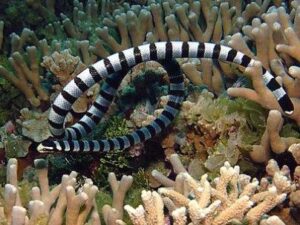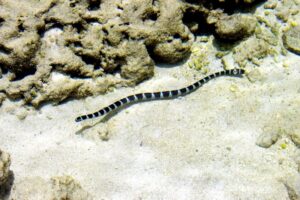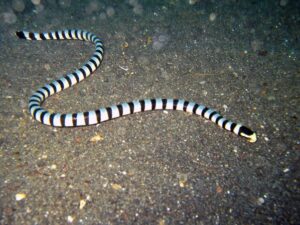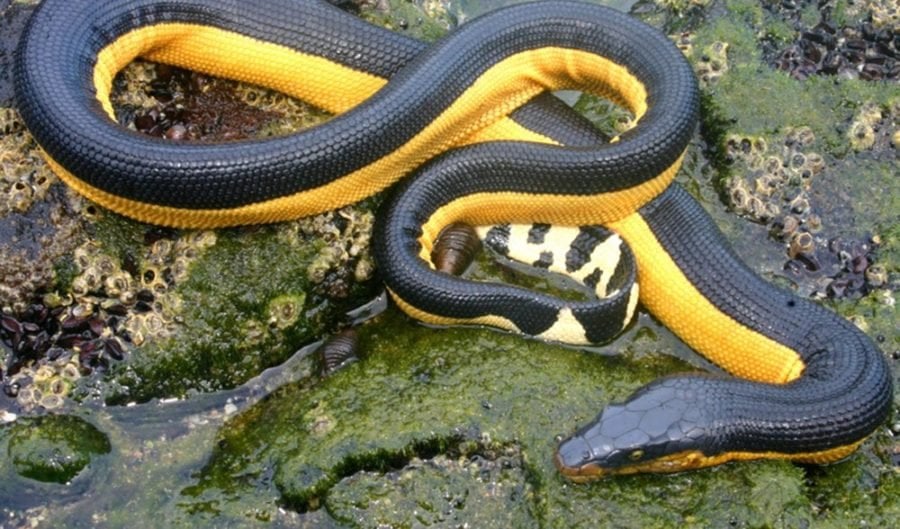The Belcher’s sea snake, also called the faint-banded sea snake, is a highly venomous species in the elapid family. In 1849, a British zoologist John Edward Gray first described and named this species. It was named after Sir Edward Belcher, a British Naval officer who discovered the snake during mid 19th century. The name of their genus ‘Hydrophis‘ is a mixture of two Greek words, hydōr meaning ‘water’ and ophis, meaning ‘serpent’.
Some people claim that the Belcher’s sea snake’s venom is extremely potent than the inland taipan’s. However, according to their LD50 values, the venom of the inland taipan is far more toxic than that of Belcher’s sea snakes.
Scientific Classifications
- Suborder:Serpentes
- Family:Elapidae
- Genus:Hydrophis
- Species:H. belcheri
Conservation Status
Description
Size
The average size of a belcher’s sea snake is between 1.6–3.1 ft (0.5 to 1 meter) with a weight of over three pounds.
Color and Appearance
These snakes have short heads and slender chrome yellowish bodies, flattened from side to side on the rear part. Both heads and bodies are covered with dark green crossbands. The undersides of their bodies do not have these bands. They have a faint yellow appearance both in and out of the water.
Their paddle-like tail helps them to swim at high speeds. They have overlapping scales, with a tubercle in the center of every dorsal scale. The ventral scales are slightly wide compared to the dorsal scales, although still very narrow. These snakes can go seven to eight hours without breathing, and while underwater, the valves on their nostrils close to keep water from getting into their lungs.
Are they Dangerous
Belcher’s sea snakes are one of the most venomous snakes in the world. Their venom has an LD50 value of 0.24 mg/kg and contains a mix of myotoxins and neurotoxins. If bitten, it can cause symptoms like excruciating abdominal pain, convulsions, diarrhea, dizziness, migraines, nausea, paralysis, and extreme vomiting.
However, these snakes are very docile and would not inflict a bite unless they are severely mistreated. Reported bites from them are scarce. Common bite victims are mostly fishermen trying to handle and release the snakes accidentally caught in their fishing nets. Envenomation only occurs in one-fourth of the bitten victims, since with relatively small fangs and mouths, their capability to inject venom is low. Also, because of these features, they have difficulties biting swimmers wearing diving gear.
Belcher’s Sea Snakes At a Glance
Distribution
They are primarily distributed throughout the Indian Ocean, ranging across the Gulf of Thailand, Indonesia, New Guinea, and the coastline of the Philippines. Specimens have been observed off the Australian coast at Ashmore Reef in the Timor Sea, while some also may live in the Solomon Islands.
Habitat
These sea snakes live in a ‘marine neritic’ habitat, which means they can only be found in the ocean and not at sea. They prefer to live in tropical reef regions where they get abundant prey. The coral reefs also serve as excellent shelter from predators. They spend most of their time underwater and only come to the surface to breathe air.
Due to the dumping of chemicals and industrial-strength acids into oceans, the coral reef habitat of these snakes is threatened. This forces the snakes to migrate away from their natural habitat and end up closer to the coastline.
Lifespan
In the wild, the average lifespan of Belcher’s sea snakes is 4-5 years.
Predators
Current observations say that sea eagles, like the white-bellied sea eagle and grey-headed fish eagle, might prey on them. Also, sharks such as the blacktip reef and the grey reef shark may hunt these snakes as both share the same habitat.
Diet
The diet of the Belcher’s sea snake shows great variety since many aquatic creatures live in their natural habitat. They primarily consume fish eggs, small fish, shellfish, and local eels.
Belcher’s sea snakes hunt by ambushing their prey from crevices and enclosed areas in their habitat and subduing it with their venom. Their high-speed swimming capability helps them overwhelm fast-swimming fish in open water.
Reproduction
Information about the reproduction of this species is unknown. However, researchers assume that similar to most sea snake species, they also give live birth to 3-4 young; their growth before being born might take 4-11 days, depending on different factors like water temperature and food sources.
Similar Species
Yellow Lipped Krait
The yellow-lipped sea krait and the Belcher’s sea snake are very similar in appearance. Although the yellow-lipped sea krait has only a distinct yellow snout, and its body has a bluish-grey hue. In comparison, the Belcher’s sea snake has a yellow-colored body from snout to tail.
Source
dovemed.com, i.pinimg.com, quoracdn.net, otlibrary.com

